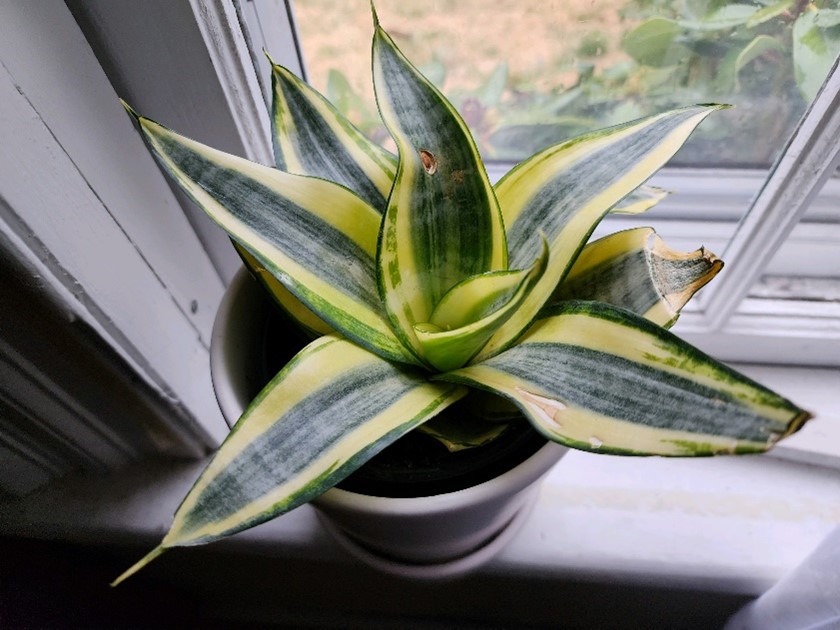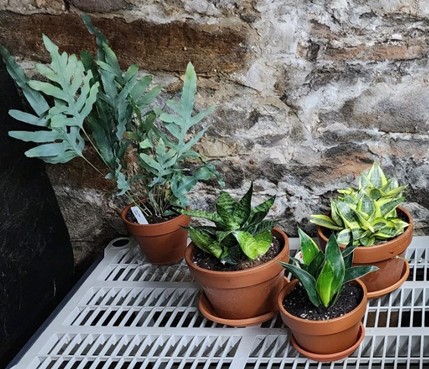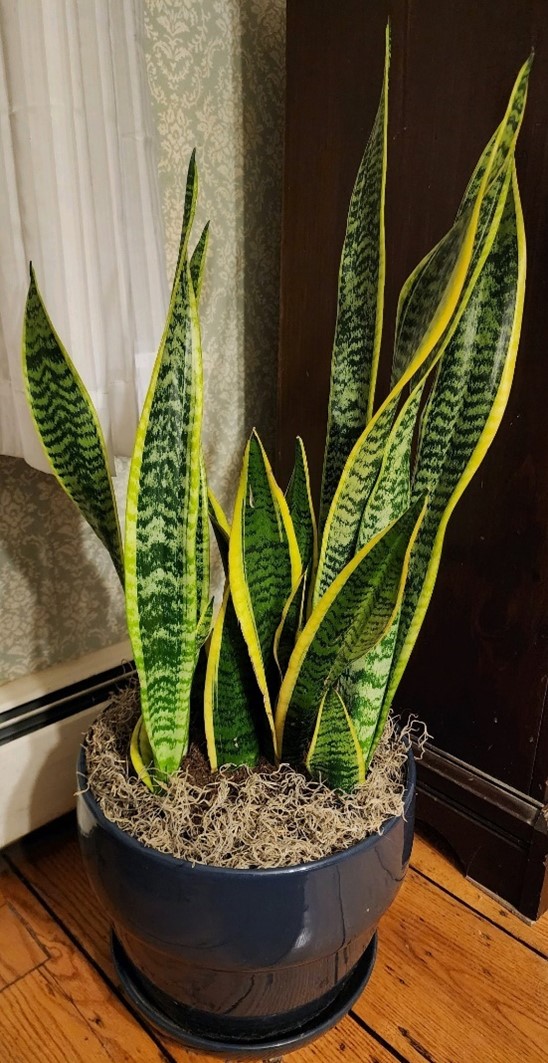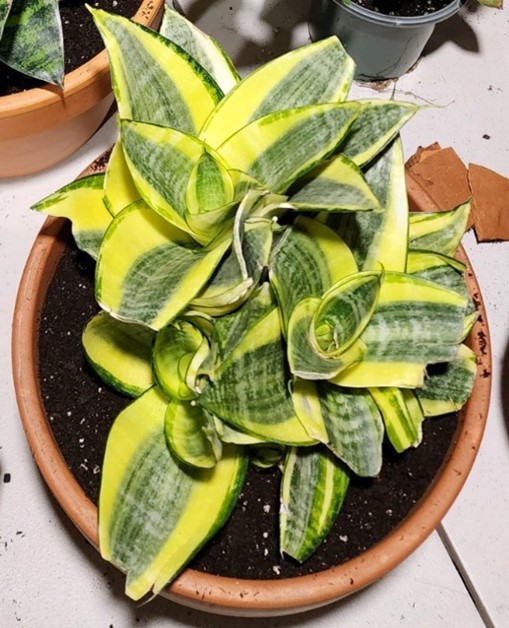The Sansevieria group makes up some of my favorite houseplants. Scientists recently placed them in the genus Dracaena, but its former scientific name seems to also be one of its common names. I will continue to refer to it as Sansevieria in this article to avoid confusion. In the future, you will most likely see the plant tags that come with plants offered for sale finally catch up with this change in the scientific community. This plant has many common names including “snake plant” and my personal favorite “mother-in-law’s tongue”. Like many varieties of houseplant, there are some staples that have been around for decades, some newer species that have come to market, and some really interesting cultivars or hybrids of all of them.
These plants have a rhizome, and the leaves grow from the base of your pot. They are very prolific when they like their environment. In fact, they tend to break the pots they are in, so I would recommend using plastic pots, which their growth will eventually deform. If you want to use a clay or ceramic pot, I suggest putting them in a slightly smaller plastic pot, then putting that in the clay pot. You can hide the gap between the two pots with Spanish moss. Being native to Africa, they cannot tolerate cold temperatures. Typical household temperatures work well, but avoid anything below 55 degrees F. If kept too cold, they will die and rot from the base up. By the time you notice there is a problem, it is too late to do anything about it. Another thing that is nice for the plant collector is that their upright growth habit allows the grower to have many varieties in a small space.
Overwatering is the quickest way to kill any houseplant, but especially so with these. In the winter, you probably only want to water once a month, and sparingly at that. Do not let them get soggy or this otherwise hardy plant will rot. In the warmer months when the plant is actively growing, allow the soil to dry between waterings, but then water more liberally. Some growers will add extra perlite to the mix to aid in drainage. I have not had trouble keeping them in a standard mix, but you certainly need to be careful with watering. Choose the mix that will work best for your plant hydration habits. These plants have the reputation of being a low light plant, which they certainly can handle. Sometimes, however, people place them in the darkest corner of a room where they hang on for a few months, but then eventually run out of stored resources and die. Remember they do need some light to photosynthesize so bright indirect light is best. The other problem I have seen is their unique, flat leaves can become covered in dust. Either dust them manually, use a blower, or take them outside in warm weather and hose them off. A damp cloth run gently over the leaves is probably the easiest method, but becomes more difficult and time consuming with a rather large collection.

All varieties of Sansevieria are fairly easy to propagate. If you want more plants quicker, you can take leaf cuttings. You either dip in rooting hormone and replant, or you can place the cuttings in water to take root (change the water daily for best results). You must be careful with the orientation, as you want to plant the bottom side of the cutting into the soil, not the top, which will fail to root. It is easy to get confused and forget which end is up. Some people put a mark on the top or bottom, others cut in such a way as to indicate the bottom. It really doesn’t matter which method you choose, if any, as long as the cuttings are oriented properly at planting time. There is one big problem with using cuttings – the babies will look like the standard green variety, and not have any of the nice golden edges, so be careful with this method. I also don’t like doing this as it, in my opinion, just looks unsightly. The remaining stub on the parent plant looks awful. If I was to do this, I would recommend cutting near the base of the plant by the soil surface. The cut leaf will not regrow, and instead just will look damaged. In the new pot where the cutting was placed, you still have to look at the cutting as it does not grow. It is not until the baby plants growing from the base are big enough that you can separate it from this actual cutting piece.
My favorite way to propagate these plants is to let them grow, and then divide them during repotting. You simply pull the plant out of the pot and divide the rhizomes up so that each plant is separate, or in small clumps. This does require the cutting or breaking of the rhizomes, but this will not hurt the plant in the long run. This method produces the best-looking plants in my opinion. Even if you just have one plant per pot, they still look nice afterwards with no short, cut, damaged leaves. In favorable conditions, they will send up some new shoots quickly and look fairly nice. The main adult plant still looks nice and uniform after repotting as it has not been cut. The best part of this propagation method is that you get exactly what you wanted. The plants have the same color and pattern as that of the parent.

The Sansevieria group can be divided into two types, those with flat leaves and those with cylindrical leaves. Of those two groups, there are species/varieties that grow tall and some that grow short. The tall ones make great floor plants while the shorter ones do well when placed on a table. Most of us are familiar with the tall green snake plant with horizontal dark green stripes. There is also a very similar one that has gold edges to each leaf. These have been around for many decades. There are some absolutely stunning new varieties on the market today that have selected for any of the colors found in these older varieties. For example, there is one called ‘Moonshine’, which has no pattern in the leaf at all, instead being pale green. Another interesting one is called ‘Hi Color’, which has more yellow than green in the leaves. The yellow is not simply along the margin, but found in the main area of the leaf as well. There are others that are selected for such a dark green that it almost approaches black in color. One of my new favorites is a different species called Sansevieria masoniana, commonly referred to as “whale tail,” “shark fin,” or some combination thereof. These can get up to 4 feet tall with proper growing conditions in a greenhouse, but generally smaller in a home setting. No matter which one you choose, you really cannot go wrong with these plants. They are readily available at most nurseries, garden centers, and home stores, so why not pick one or two up and brighten up your home?
Matthew Lisy PhD
UConn Adjunct Professor


